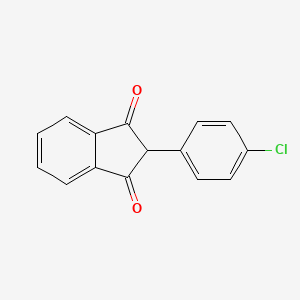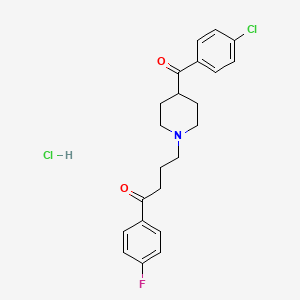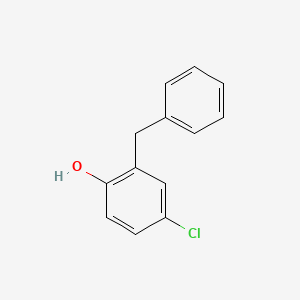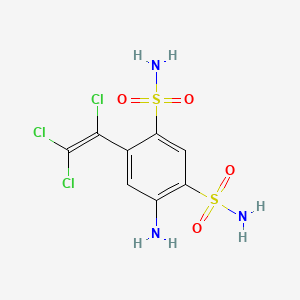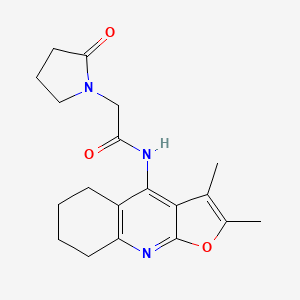
Coluracetam
Vue d'ensemble
Description
Coluracetam, également connu sous son nom chimique N-(2,3-diméthyl-5,6,7,8-tétrahydrofuro[2,3-b]quinolin-4-yl)-2-(2-oxo-1-pyrrolidinyl)acétamide, est un membre de la famille des composés nootropes racetam. Initialement développé par Mitsubishi Tanabe Pharma Corporation pour le traitement de la maladie d'Alzheimer, il a depuis été exploré pour ses avantages potentiels dans l'amélioration des fonctions cognitives, de la mémoire et de l'humeur .
Applications De Recherche Scientifique
Coluracetam has been investigated for various scientific research applications:
Chemistry: Studied for its unique chemical structure and potential to form novel derivatives.
Biology: Explored for its effects on neurotransmitter systems, particularly acetylcholine.
Medicine: Investigated for its potential to treat cognitive disorders, depression, and anxiety.
Industry: Used in the development of nootropic supplements aimed at enhancing cognitive function and mood.
Mécanisme D'action
Target of Action
The primary target of Coluracetam is the high-affinity choline uptake (HACU) in neurons . Choline is a precursor to the neurotransmitter acetylcholine, which plays a crucial role in cognitive processes such as memory formation, learning, and attention .
Mode of Action
This compound interacts with its target, the high-affinity choline transporter (HACU), which is responsible for transporting choline across the cell membrane and into neurons . By enhancing the efficiency of the choline transport system, this compound promotes the synthesis and release of acetylcholine, ultimately leading to improved cognitive function .
Biochemical Pathways
This compound affects the cholinergic system, specifically the pathway of acetylcholine synthesis . By enhancing high-affinity choline uptake, this compound increases the levels of acetylcholine, a crucial neurotransmitter associated with memory and cognition . This increase can help with memory formation and retention, making the brain work more efficiently and supporting various mental tasks .
Pharmacokinetics
This compound appears to have very rapid kinetics, with a peak in blood at around 30 minutes and on the decline within 3 hours . Due to this, supplementation may be time-dependent in relation to activity . It is fat-soluble, so it needs fats for optimal absorption . It’s usually taken sublingually (under the tongue) or orally . This method enhances its bioavailability .
Result of Action
The molecular and cellular effects of this compound’s action are primarily related to its enhancement of acetylcholine synthesis. By increasing the levels of acetylcholine, this compound improves cognitive functions such as memory formation, learning, and attention . It has been shown to improve learning impairment on a single oral dose given to rats which have been exposed to cholinergic neurotoxins .
Action Environment
The action, efficacy, and stability of this compound can be influenced by various environmental factors. For instance, the presence of fats in the environment (i.e., the user’s diet) can affect the absorption of this fat-soluble compound . Furthermore, the timing of supplementation in relation to activity can influence the compound’s effects due to its rapid kinetics .
Analyse Biochimique
Biochemical Properties
The primary mechanism of action for coluracetam is its ability to increase the uptake of choline into neurons . Choline is a precursor to the neurotransmitter acetylcholine, which plays a crucial role in cognitive processes such as memory formation, learning, and attention . This compound achieves this by interacting with the high-affinity choline transporter (HACU), which is responsible for transporting choline across the cell membrane and into neurons . By enhancing the efficiency of the choline transport system, this compound promotes the synthesis and release of acetylcholine .
Cellular Effects
This compound works mainly by increasing the levels of acetylcholine, a crucial neurotransmitter, and modulating choline uptake in the brain . Its unique mechanisms make it interesting for cognitive enhancement and potential therapeutic uses . Enhancement of Acetylcholine Synthesis: this compound boosts acetylcholine synthesis . Acetylcholine is vital for learning and memory . The brain uses choline to produce acetylcholine . By enhancing this process, this compound improves cognitive functions .
Molecular Mechanism
This compound enhances high-affinity choline uptake (HACU), which is the rate-limiting step of acetylcholine (ACh) synthesis . Studies have shown this compound to improve learning impairment on a single oral dose given to rats which have been exposed to cholinergic neurotoxins . Subsequent studies have shown that it may induce long-lasting procognitive effects in cholinergic neurotoxin-treated rats by changing the choline transporter regulation system .
Dosage Effects in Animal Models
Most of the research on this compound was done on animals rather than humans, so there are no universally accepted dosing guidelines . In a 2010 animal study, this compound improved artificially-induced memory deficits without producing any significant side effects .
Transport and Distribution
This compound is fat-soluble, so it needs fats for optimal absorption . It’s usually taken sublingually (under the tongue) or orally . This method enhances its bioavailability .
Subcellular Localization
Given its mechanism of action, it is likely that this compound interacts with neurons in the brain where it enhances the uptake of choline, a precursor to the neurotransmitter acetylcholine .
Side effects and long-term safety remain areas requiring more comprehensive research .
Méthodes De Préparation
Voies de synthèse et conditions de réaction : Coluracetam est synthétisé par un processus en plusieurs étapes impliquant la réaction de la 2,3-diméthyl-5,6,7,8-tétrahydrofuro[2,3-b]quinoline avec le 2-oxo-1-pyrrolidineacetamide. Les étapes clés incluent :
Formation du noyau quinoline : Cela implique des réactions de cyclisation dans des conditions contrôlées.
Attachement du groupe pyrrolidinyl : Cette étape nécessite généralement l'utilisation de réactifs de couplage et de catalyseurs pour assurer un rendement et une pureté élevés.
Méthodes de production industrielle : La production industrielle de this compound suit des voies de synthèse similaires mais à plus grande échelle. Le processus est optimisé pour l'efficacité, la rentabilité et le respect des normes réglementaires. Les considérations clés incluent :
Échelle de réaction : S'assurer que les réactions peuvent être mises à l'échelle sans perte de rendement ou de pureté.
Purification : Utiliser des techniques telles que la cristallisation et la chromatographie pour obtenir les niveaux de pureté souhaités.
Analyse Des Réactions Chimiques
Types de réactions : Coluracetam subit diverses réactions chimiques, notamment :
Oxydation : Cela peut se produire dans des conditions spécifiques, conduisant à la formation de dérivés oxydés.
Réduction : Les réactions de réduction peuvent modifier les groupes fonctionnels, modifiant potentiellement l'activité du composé.
Substitution : Les réactions de substitution peuvent introduire différents groupes fonctionnels, ce qui peut améliorer ou diminuer ses propriétés nootropes.
Réactifs et conditions communs :
Agents oxydants : Tels que le permanganate de potassium ou le peroxyde d'hydrogène.
Agents réducteurs : Y compris le borohydrure de sodium ou l'hydrure d'aluminium et de lithium.
Catalyseurs : Souvent utilisés dans les réactions de substitution pour augmenter les vitesses de réaction et les rendements.
Produits principaux : Les principaux produits de ces réactions sont des formes modifiées de this compound, qui peuvent avoir des propriétés pharmacologiques différentes. Ces dérivés sont souvent étudiés pour comprendre les relations structure-activité.
4. Applications de recherche scientifique
This compound a été étudié pour diverses applications de recherche scientifique :
Chimie : Étudié pour sa structure chimique unique et son potentiel à former de nouveaux dérivés.
Biologie : Exploré pour ses effets sur les systèmes de neurotransmetteurs, en particulier l'acétylcholine.
Médecine : Étudié pour son potentiel à traiter les troubles cognitifs, la dépression et l'anxiété.
Industrie : Utilisé dans le développement de compléments nootropes visant à améliorer les fonctions cognitives et l'humeur.
5. Mécanisme d'action
This compound améliore principalement l'absorption de la choline à haute affinité (HACU), qui est l'étape limitante dans la synthèse de l'acétylcholine, un neurotransmetteur crucial pour l'apprentissage et la mémoire . En augmentant la disponibilité de la choline, this compound stimule la production d'acétylcholine, améliorant ainsi les fonctions cognitives. Il module également le système de régulation du transporteur de choline, conduisant à des effets procognitifs durables .
Composés similaires :
Piracetam : Le premier nootrope racetam, connu pour ses effets améliorateurs des fonctions cognitives.
Aniracetam : Un autre racetam aux avantages anxiolytiques et cognitifs.
Oxiracetam : Connu pour ses effets stimulants et son amélioration des fonctions cognitives.
Unicité de this compound : this compound est unique en raison de son mécanisme spécifique d'amélioration de l'absorption de la choline à haute affinité, qui n'est pas observé dans d'autres racetams. Cette action distincte le rend particulièrement efficace pour améliorer la mémoire et l'apprentissage dans les conditions où la fonction cholinergique est compromise .
Comparaison Avec Des Composés Similaires
Piracetam: The first racetam nootropic, known for its cognitive-enhancing effects.
Aniracetam: Another racetam with anxiolytic and cognitive benefits.
Oxiracetam: Known for its stimulating effects and cognitive enhancement.
Uniqueness of Coluracetam: this compound is unique due to its specific mechanism of enhancing high-affinity choline uptake, which is not observed in other racetams. This distinct action makes it particularly effective in improving memory and learning in conditions where cholinergic function is compromised .
Propriétés
IUPAC Name |
N-(2,3-dimethyl-5,6,7,8-tetrahydrofuro[2,3-b]quinolin-4-yl)-2-(2-oxopyrrolidin-1-yl)acetamide | |
|---|---|---|
| Source | PubChem | |
| URL | https://pubchem.ncbi.nlm.nih.gov | |
| Description | Data deposited in or computed by PubChem | |
InChI |
InChI=1S/C19H23N3O3/c1-11-12(2)25-19-17(11)18(13-6-3-4-7-14(13)20-19)21-15(23)10-22-9-5-8-16(22)24/h3-10H2,1-2H3,(H,20,21,23) | |
| Source | PubChem | |
| URL | https://pubchem.ncbi.nlm.nih.gov | |
| Description | Data deposited in or computed by PubChem | |
InChI Key |
PSPGQHXMUKWNDI-UHFFFAOYSA-N | |
| Source | PubChem | |
| URL | https://pubchem.ncbi.nlm.nih.gov | |
| Description | Data deposited in or computed by PubChem | |
Canonical SMILES |
CC1=C(OC2=NC3=C(CCCC3)C(=C12)NC(=O)CN4CCCC4=O)C | |
| Source | PubChem | |
| URL | https://pubchem.ncbi.nlm.nih.gov | |
| Description | Data deposited in or computed by PubChem | |
Molecular Formula |
C19H23N3O3 | |
| Source | PubChem | |
| URL | https://pubchem.ncbi.nlm.nih.gov | |
| Description | Data deposited in or computed by PubChem | |
DSSTOX Substance ID |
DTXSID60159386 | |
| Record name | Coluracetam | |
| Source | EPA DSSTox | |
| URL | https://comptox.epa.gov/dashboard/DTXSID60159386 | |
| Description | DSSTox provides a high quality public chemistry resource for supporting improved predictive toxicology. | |
Molecular Weight |
341.4 g/mol | |
| Source | PubChem | |
| URL | https://pubchem.ncbi.nlm.nih.gov | |
| Description | Data deposited in or computed by PubChem | |
CAS No. |
135463-81-9 | |
| Record name | Coluracetam | |
| Source | CAS Common Chemistry | |
| URL | https://commonchemistry.cas.org/detail?cas_rn=135463-81-9 | |
| Description | CAS Common Chemistry is an open community resource for accessing chemical information. Nearly 500,000 chemical substances from CAS REGISTRY cover areas of community interest, including common and frequently regulated chemicals, and those relevant to high school and undergraduate chemistry classes. This chemical information, curated by our expert scientists, is provided in alignment with our mission as a division of the American Chemical Society. | |
| Explanation | The data from CAS Common Chemistry is provided under a CC-BY-NC 4.0 license, unless otherwise stated. | |
| Record name | Coluracetam [INN] | |
| Source | ChemIDplus | |
| URL | https://pubchem.ncbi.nlm.nih.gov/substance/?source=chemidplus&sourceid=0135463819 | |
| Description | ChemIDplus is a free, web search system that provides access to the structure and nomenclature authority files used for the identification of chemical substances cited in National Library of Medicine (NLM) databases, including the TOXNET system. | |
| Record name | Coluracetam | |
| Source | EPA DSSTox | |
| URL | https://comptox.epa.gov/dashboard/DTXSID60159386 | |
| Description | DSSTox provides a high quality public chemistry resource for supporting improved predictive toxicology. | |
| Record name | COLURACETAM | |
| Source | FDA Global Substance Registration System (GSRS) | |
| URL | https://gsrs.ncats.nih.gov/ginas/app/beta/substances/V6FL6O5GR7 | |
| Description | The FDA Global Substance Registration System (GSRS) enables the efficient and accurate exchange of information on what substances are in regulated products. Instead of relying on names, which vary across regulatory domains, countries, and regions, the GSRS knowledge base makes it possible for substances to be defined by standardized, scientific descriptions. | |
| Explanation | Unless otherwise noted, the contents of the FDA website (www.fda.gov), both text and graphics, are not copyrighted. They are in the public domain and may be republished, reprinted and otherwise used freely by anyone without the need to obtain permission from FDA. Credit to the U.S. Food and Drug Administration as the source is appreciated but not required. | |
Retrosynthesis Analysis
AI-Powered Synthesis Planning: Our tool employs the Template_relevance Pistachio, Template_relevance Bkms_metabolic, Template_relevance Pistachio_ringbreaker, Template_relevance Reaxys, Template_relevance Reaxys_biocatalysis model, leveraging a vast database of chemical reactions to predict feasible synthetic routes.
One-Step Synthesis Focus: Specifically designed for one-step synthesis, it provides concise and direct routes for your target compounds, streamlining the synthesis process.
Accurate Predictions: Utilizing the extensive PISTACHIO, BKMS_METABOLIC, PISTACHIO_RINGBREAKER, REAXYS, REAXYS_BIOCATALYSIS database, our tool offers high-accuracy predictions, reflecting the latest in chemical research and data.
Strategy Settings
| Precursor scoring | Relevance Heuristic |
|---|---|
| Min. plausibility | 0.01 |
| Model | Template_relevance |
| Template Set | Pistachio/Bkms_metabolic/Pistachio_ringbreaker/Reaxys/Reaxys_biocatalysis |
| Top-N result to add to graph | 6 |
Feasible Synthetic Routes
Avertissement et informations sur les produits de recherche in vitro
Veuillez noter que tous les articles et informations sur les produits présentés sur BenchChem sont destinés uniquement à des fins informatives. Les produits disponibles à l'achat sur BenchChem sont spécifiquement conçus pour des études in vitro, qui sont réalisées en dehors des organismes vivants. Les études in vitro, dérivées du terme latin "in verre", impliquent des expériences réalisées dans des environnements de laboratoire contrôlés à l'aide de cellules ou de tissus. Il est important de noter que ces produits ne sont pas classés comme médicaments et n'ont pas reçu l'approbation de la FDA pour la prévention, le traitement ou la guérison de toute condition médicale, affection ou maladie. Nous devons souligner que toute forme d'introduction corporelle de ces produits chez les humains ou les animaux est strictement interdite par la loi. Il est essentiel de respecter ces directives pour assurer la conformité aux normes légales et éthiques en matière de recherche et d'expérimentation.




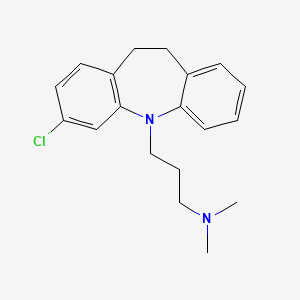


![methyl 2-(2-chlorophenyl)-2-(6,7-dihydrothieno[3,2-c]pyridin-5(4H)-yl)acetate sulfate](/img/structure/B1669226.png)




